#white-legged snake millipede
Explore tagged Tumblr posts
Text


A millipede I saw on a beech tree today, which I think is a White-legged snake millipede. It has around 100 pairs of legs and mostly eats algae and similar stuff.
Source:
14 notes
·
View notes
Text
Bestiaryposting Results: Gaersnae
This one seems to be flying under the radar, identification-wise, much more than I expected, which is a pleasant surprise. I don't have anything else to add at the beginning of this post. The entry people are working from is here:
And if you don't know what this "bestiaryposting" business is, you can find an explanation and all previous posts at https://maniculum.tumblr.com/bestiaryposting.
Now, art in roughly chronological order:

@silverhart-makes-art (link to post here) has made the entirely logical decision that the "king of crawling things" should be whichever creature has the most legs, and drawn us a millipede large enough to fight a weasel. I think this is a good and sensible direction, and that's a quality depiction of a millipede/weasel fight right there.
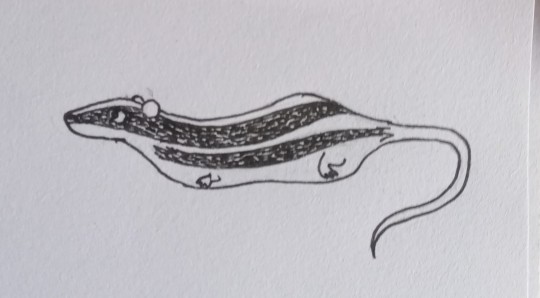
@sweetlyfez (link to post here) has gone in a more rodent-y direction, with the interesting detail that, as a result of living in caves, its legs are gradually becoming vestigial. I think this is also quite clever, and the rat is pretty cute.
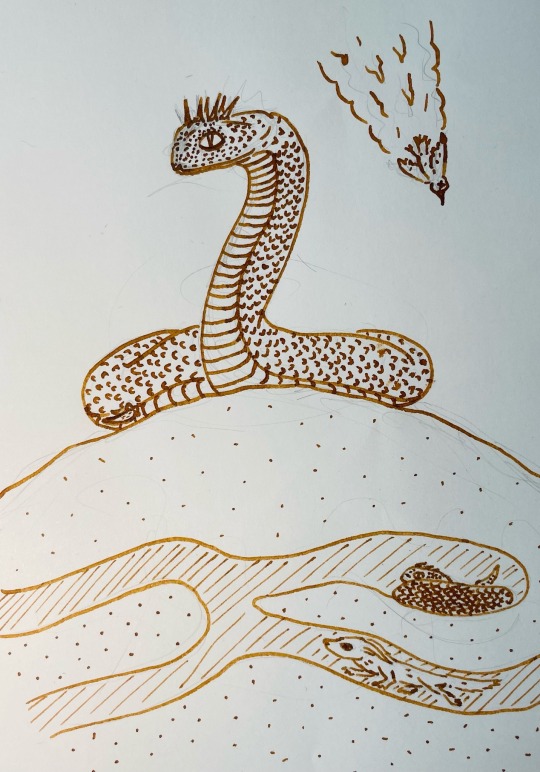
@cheapsweets (link to post here) decided that the "king of crawling things" should have no legs, as maximum crawling happens when one is flat on one's belly. Hence our crowned snake -- complete with a bird going down in flames near the top of the drawing, and a weasel/Hreksong invading the burrows near the bottom. I think the "crown" works really well, and it's always nice to see a callback to previous beasts. As usual, CheapSweets has provided an interesting and informative explanation of their design in the linked post -- I particularly liked the phrase "pelvic spur for extra rizz".
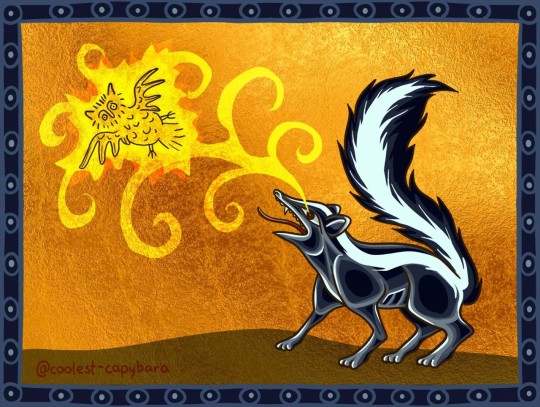
@coolest-capybara (link to post here) is running with the idea of a creature that kills with its scent (and has white stripes), so we have this amazing picture of a skunk zapping an owl out of the sky. The medieval skunk is excellent -- I think if they had skunks in medieval Europe, that's probably how they would have drawn them -- and the scribbly owl is just delightful. Check the linked post for additional observations and a link to a short but informative source about medieval owls.
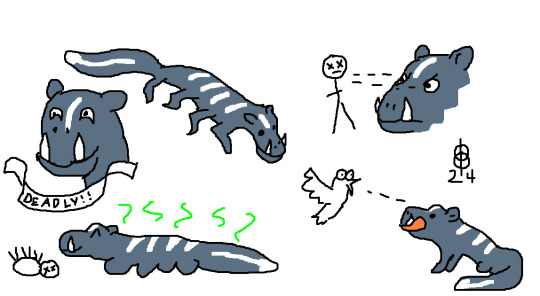
@pomrania (link to post here) also has some skunk inspiration going on here, though their version has some extra legs and a kind of boar-like face. A very informative series of drawings about how this thing can kill you -- I particularly like the one with the little scroll reading "deadly!!"
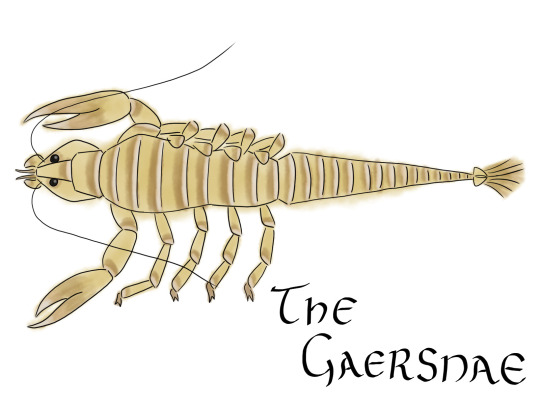
@strixcattus (link to post here) has contributed an invertebrate, which I think makes this one of the only entries that's gotten more than one of those. And that's a solid drawing of an arthropod -- I also like the lettering at the bottom right there. As usual, I implore you to read the write-up in the linked post, where the animal is re-imagined from the perspective of a modern naturalist.
Okay, Aberdeen Bestiary:
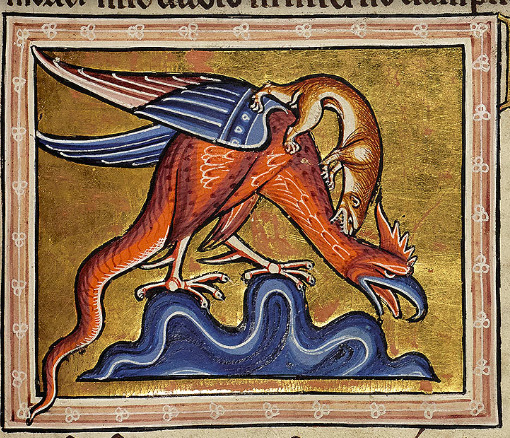
So this is actually a case of the artist's preconceptions making them mess it up a bit. You may notice that it does not fit the description. It also sticks out a bit in the context of the bestiary, because it's in the "snake" section of the manuscript.
What's happened here is that this is the entry for the basilisk, but the artist has drawn a cockatrice. This is not actually unusual, as the two mythical beasts are hopelessly entangled in the tradition; I looked into it a bit, and it seems like there's actually some confusion about where the cockatrice even comes from. Probably the reason the two creatures have similar powers attributed to them is because the cockatrice kind of inherited that aspect from the basilisk.
(See, e.g., Breiner, Laurence A. "The Career of the Cockatrice." Isis, vol. 70, no. 1, 1979, pp. 30–47.)
Anyway, the basilisk is so called because it is the king of snakes -- basileus is Greek for "king", and -iskos is a diminutive. Little king.
(The translation provided by the University of Aberdeen, "king of crawling things," is unusual -- the Latin reads "rex serpentium". It's possible this translation choice is because of the flexibility of the term "serpent".)
This is a creature originally described by classical authors and then passed along through medieval European sources. It has white stripes, often some sort of "crown" on its head, is venomous, and is sometimes said to distinguish itself from other snakes by holding the front part of its body regally upright... yeah, it's obviously a cobra that's been telephoned and exaggerated into being ludicrously deadly. Just swap out "weasel" for "mongoose" -- I think that's pretty clearly a case of some author who distantly predated scientific taxonomy just going, "looks like a weasel to me".
Also, this entry ends with:
The creature called sibilus is the same as the regulus, or basilisk; for it kills with its hiss before it bites or burns.
I am not aware of any creature called sibilus.
28 notes
·
View notes
Note
how would the name Centipedeslither be translated into clanmew? :3
Centipedes! Segmented bugs with lots of legs that live in the leaf litter. Clan cats do not have a knowledge of cladistics, so there are three animals that get put into this broad category and one of these things is not like the others;
Generic Term (Segmented 'bug' that keeps its belly low to the ground) = Ugoogi
Centipede = Gishi
Milipede = Perra
Rollypolly/Woodlouse/pillbug = Booi
Curl Up (The action of rolling up into a ball) = Arreoopa/Arreoop/Arreoo
Slither (the action of moving so close to the ground that your belly drags) = Hehhefe/Hehhef/Hehhe
If you're a Critter Fan, you'll know right away that Rollypollies are actually a type of land crustacean! If you tried to explain this to a Clan cat, they would imagine river shrimp and crayfish, and call you a fucking liar.
ShadowClan and ThunderClan encounter these things a lot, and have a few unique words for the favorite species in each category.
So the short and most generic answer for your Centipedeslither cat would be Gishihehhef, "Centipede-slithering," but the longer answer with specific species to choose from...
(WARNING! BUGS BELOW!)
CENTIPEDES (Gishi)
A Gishishi is different from a Perra, to Clan cats, because a Gishishi has legs further splayed out. They also tend to be better hunters, ergo, they are more respected.
ShadowClan likes to eat them.
Western Yellow Centipede (Haplophilus subterraneus) = Rreeshi

This is the gentlest type of centipede there's a unique word for, the rest are pretty active hunters and a Clan cat could probably be convinced that it's a Perra. This thing is BRIGHT golden and hard to ignore, making it an animal that Clan cats think is quite beautiful.
Stone Centipedes (Lithobiomorpha) = Gnoshi
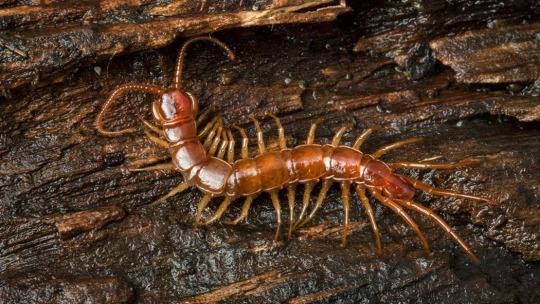
These ones are seen under just about any type of rotting wood or leaf litter, and are large and juicy enough that ShadowClan will bother to collect them for a soup.
They have a formidable power; a venomous bite that can make a warrior's paw sting for a while. They can't cause lasting damage, but a careless apprentice would get a painful warning.
And the last one is an interesting type.
House Centipede (Scutigera coleoptrata) = Mwrshi
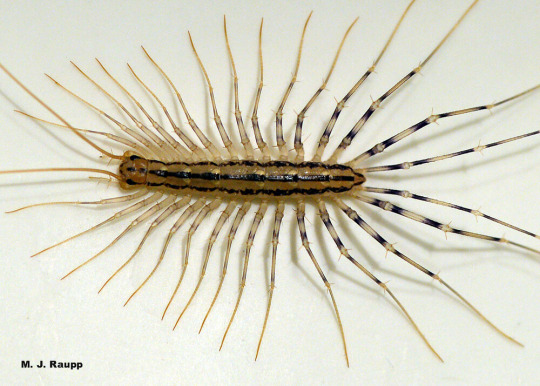
These animals are exclusively a bad omen.
This species of centipede is VERY rare this far north in the UK. They require a large population of lesser insects to feast on, such as silverfish. They don't like the climate, and so, they occasionally are found in dens.
Their bite can be very painful, but most of all, they are a sign of uncleanliness and disorder below the surface. Messengers of underlying problems, with whiskers for legs, as if commanding Clan cats to keep their senses sharp.
MILIPEDES (Perra)
Milipedes are different from centipedes to Clan cats for having more legs, tucked neatly under their bodies, and often being able to roll up into a little coil! They are seen as cute, less threatening than centipedes, meek and cowardly.
They also don't taste as good, much like a long rollypolly. ShadowClan will still eat them though, with seasonings.
TRIVIA: Milipedes of the genus Polydesmus follow the body plan that Clan cats associate with "centipedes"! Legs splayed to the side. So they classify those as centipedes, not milipedes.
Blunt-tailed Snake Millipede (Cylindroiulus punctatus) = Oskerra
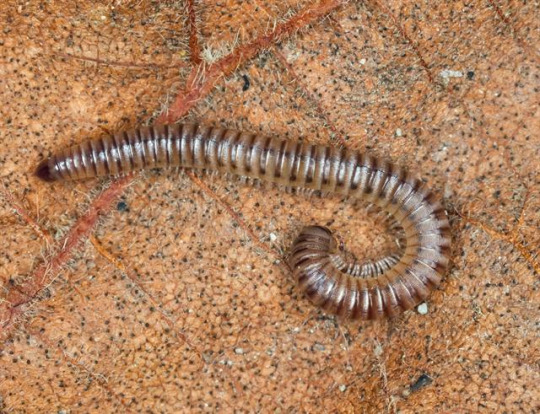
Shockingly long-lived for an insect, taking 3 years before it reaches maturity. There is a Clanmew saying about this, "I would rather live a moon as a stone centipede than many seasons as an Oskerra."
Striped Milipede (Ommatoiulus sabulosus) = Uberra

The most commonly seen milipede in ShadowClan, with the ability to break down pine needles and tolerating wet conditions. Seen as a harder worker than the other two, but still as gentle and cowardly as its cousins.
White-legged Snake Milipede (Ommatoiulus sabulosus) = Lubrerra
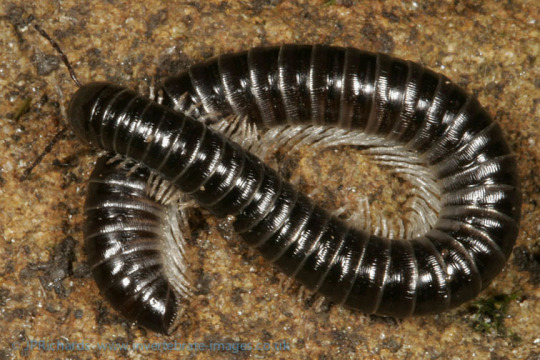
Usually seen exclusively in ThunderClan, as they don't like extremely wet conditions. A shame, as ShadowClan in particular thinks they're very pretty and envy that they don't live by them.
When ShadowClan does manage to take land from ThunderClan, they will often make a soup out of this type of millipede to be smug about it. ThunderClan doesn't even LIKE eating bugs but BOY does it offend them!
ROLLYPOLLIES (Booi)
Now the first thing you're gonna get to know about these little things is that there is an impostor in their midst. This is the biggest class in this category of animals, with a whopping total of 6 animals, and one of them is secretly a milipede!
Again, though, if you told this to a Clan cat they would think you are a dirty liar.
All of these are sometimes tossed into meals to add a crunchy texture. MOST of them cannot curl!
Common Pill Millipede (Glomeris marginata) = Sipooi
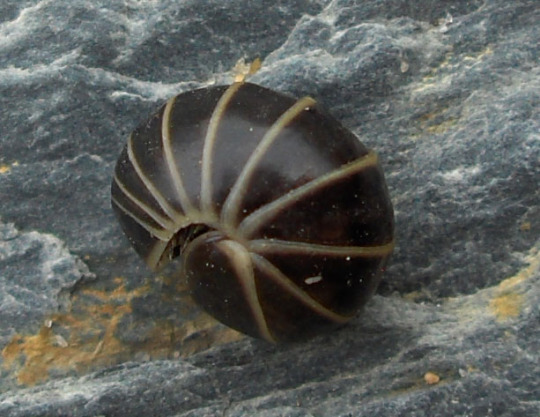
Seen as a sign of good luck when sighted near other Booi, as they are one of the hardiest of their category and are capable of surviving in conditions the others can't. They even sometimes stroll in bright sunlight!
They very rarely display ginger flecks on their black segments like a tortoiseshell cat. When this is the case, it's a wonderful omen.
Common Shiny Woodlouse (Oniscus asellus) = Shemooi
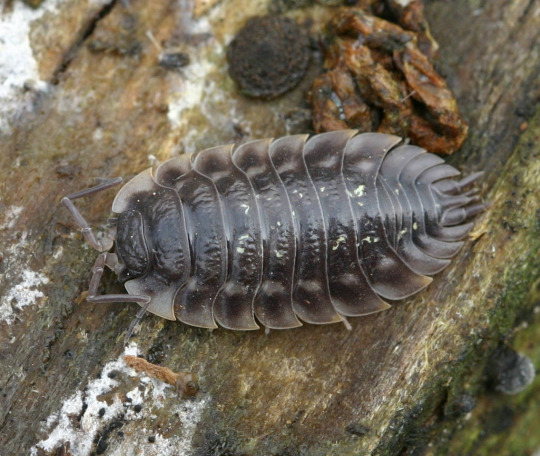
Totally incapable of curling up, and the only woodlouse that WindClan is familiar with. It happily hangs out on the lone bits of rotting wood out in the moorland, like fenceposts, trees, dead heather bushes, and so on.
Shining is associated with StarClan in all contexts and the little yellow flecks are seen as star-like, so WindClan confidently believes that StarClan only allow the holiest of Booi into their territory. Unlike the other Clans whose booi are rough and shineless.
Gucci Booi
Common Rough Woodlouse (Porcellio scaber) = Karkooi

ShadowClan's favorites, for their love of wet environments and total inability to curl. They come in a WIDE array of colors, from blue-gray to russet-red to pale orange.
These make excellent first-time pets for a young kit, before they're ready for the responsibility of mealworms. Keeping karkooi is enjoyable for collecting pretty colors, and rotting wood is even easier to find than collecting scraps of fruit and crowfood.
They even display individual personalities, like being shy, brave, or outgoing, and are completely unable to bite. Kittens can become VERY attached to their pets!
Common Striped Woodlouse (Philoscia muscorum) = Gishooi
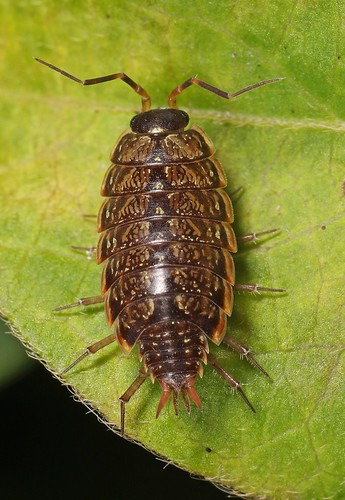
By far the fastest of this group, with a gorgeous dappled pattern. Seen as a hybrid between Rollypollies and Centipedes, but due to the very different nature of its parents, it has the strengths of neither.
Common Pill Woodlouse (Armadillidium vulgare) = Buabooi
The one you've all been waiting for.

The most iconic of this family, the one that immediately comes to our minds when we think of rollypollies. Round, majestic, found in dark soil and under nearly every rock in a forest.
Uncontested as a detritivore and integral to the breakdown of leaf litter in a forest, Clan cats see these poor little guys as helpless cowards who roll up instead of running away. Still, kits love to bother them and see them curl up into tight little nuts, poking them around with their claws.
#Clanmew#Insects#Centipedes#Milipedes#Conlang#Clanmew Expansion Pack#Rollypollies#Pillbugs#cw insects#bugs
64 notes
·
View notes
Text
I've been pining over how perfect the aesthetics of Bloodborne are for years. I can't believe I hesitated to play it until now because internet memes made me think I wouldn't be good enough to enjoy it.
What an experience this was.
This game scratched so many itches. It scratched all the itches.
It's got The Most™ setting:
Cosmic Horror in a non-modern, non-sci-fi setting
Fantasy with early modern firearms
Plot centered around a bloodborne curse that turns everyone into blood-drunk beasts and there's a lot of blood drinking and blood transfusions and blood in general, but it's not about vampires
No vampires
But werewolves
So many werewolves
Set in a decaying, once great metropolis (think Victorian London but more apocalyptic)
NO VAMPIRES
Moon's haunted
and Themes:
The thing that strengthens you is irreversibly changing you, body and mind.
Blood (blood as power, blood as a means of healing, blood as a carrier of corruption and disease)
Moon's haunted.
Monster hunters slowly and inevitably turning into monsters.
Scholars pulled on too many threads of reality until it became unravelled. Leading to:
Morally orange-and-blue Great Ones who just do normal Great Ones things and don't understand or care that their effects on humanity are horrifying
Panacea revealed to be a curse
The Veil™ being ripped from your eyes, allowing you to see behind The Facade™
Themes tied into game mechanics and vice-versa, e.g.: The more insight (about the world/the truth/the moon) you have, the more vulnerable you are to certain effects and some mobs will have crazier abilities and you will hear the song more clearly and you will get to see THEM early.
Lighting lamps
Reflections (in dreams, in nightmares, in mirrors, in water, in a doll)
Holy Church associated with Light and Healing is actually a Corrupt Church Ruining Everything for Everyone because of curiosity and lust for power. Leading to:
Clergy involuntarily, painfully turning into beasts
MOON'S HAUNTED!
Something something moon phases and blood and conception and ascension through (re-)birth and female monsters
and the Aesthetics:
Street lamps and cast iron fences and broken church windows
Everybody's wearing cute hats and embroidered vests and long coats and capes...
or tattered nazghul robes
Tentacles!
Moon phases
Eyes where eyes shouldn't be
Haunted Gothic Horror Castle! Haunted Gothic Horror Castle!
Tattered ghostly black driverless horse-drawn carriage taking you to Haunted Gothic Horror Castle!
Snakes growing out of headless people's empty neck holes
Crow lady with plague doctor mask
Spear guns and hand cannons and swords that turn into hammers and the lollipop saw
So many eyes
Fluffy deer-dog beasts!
Laurence, where is your skull?
Laurence, where did your legs go?
Laurence
So many distinct but beautiful designs for the Great Ones and their kin
Moon Presence goes brrrr.
Moon's haunted.
Graceful and fluffy ethereal millipede
The Mad Ones' whole anime demon aesthetic
The final boss fight(s) take(s) place in a field of white moon flowers, under the blood moon.
... and the rest:
Cthulhu death laser
The brain juice lady
The lake is upside down. That's why you can't see the moon.
If you raise the staircase, the level layout changes.
Dude's a horse now.
#bloodborne#bloodborne spoilers#faves#video games#im absolutely feral about this game#i have NEVER seen anything like it#there is NOTHING else like it#it's so beautiful
19 notes
·
View notes
Video
Resting Millipede by Oliver Andrews Via Flickr: A white-legged snake millipede sheltering in the colour band on a way-marker post, in Short Wood.
#canon#canonuk#invertebrate#invertebrates#minibeast#minibeasts#myriapod#myriapods#nature#nature reserve#northamptonshire#outdoors#short wood and southwick wood#tachypodoiulus niger#white-legged snake millipede#wildlife#wildlife trust#wildlife trusts#wood#woodland#woods#Peterborough#England#United Kingdom#flickr
2 notes
·
View notes
Text

I will elaborate. I have a shinigami (Death Note) oc. Her name is Lyce (pronounced like Lies). She has four black eyes on her right side and one normal human brown eye. She has one eye with a blue pupil and black sclera on her left side. I have a bit of a fic written that would include her, where instead of Sidoh's Death Note, Ryuk gave Light hers. Who knows if / when it'll be available to read.
A long image ID and a close up of her face below the cut.
ID: A grotesque creature in front of a red and grey background. She holds aloft a floating apple that radiates white and yellow upon the background which resembles a burning city. She has white millipede buns on her blue hair, and red brown horns. Her lips are stretched over fangs and she has a snake bite piercing. She has a bridge piercing, and earrings that resemble a dagger, two skulls (one is upside down) and a large hoop holding a skeleton that looks as if it is being hung by a chain. She has five visible eyes as her face is turned toward the apple, and tear streaks down her face and cracks raising from her neck. She is wearing a collar patterned with skulls, a sheer short sleeve, and a black bra, below which her ribs and signs of a heart are visible. Beneath her ribs, her flesh seems to resume over the bones and is decorated with a few rings and a little hummingbird charm. Her hips spread out into six insect-like legs, and a long reptilian tail. Her nails are long and blue, and her elbow exposes a purple point, like a stinger. End ID

#body horror#insect#skull#skeleton#gore#death note#sorry for putting this in a main tag i just want people to be able to blacklist#oc tag: lyce#my art#i made this#ask to tag
12 notes
·
View notes
Photo
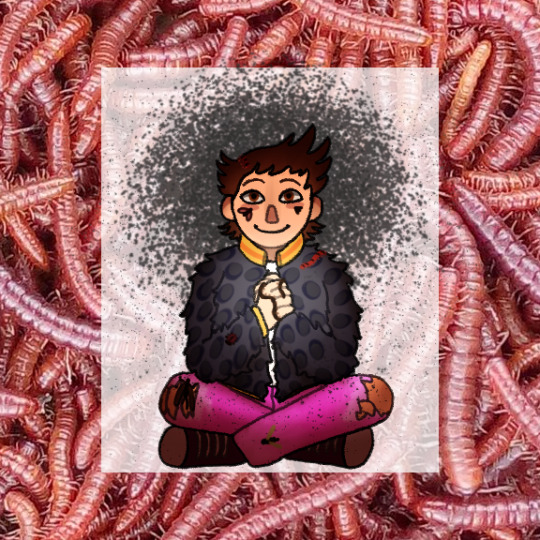

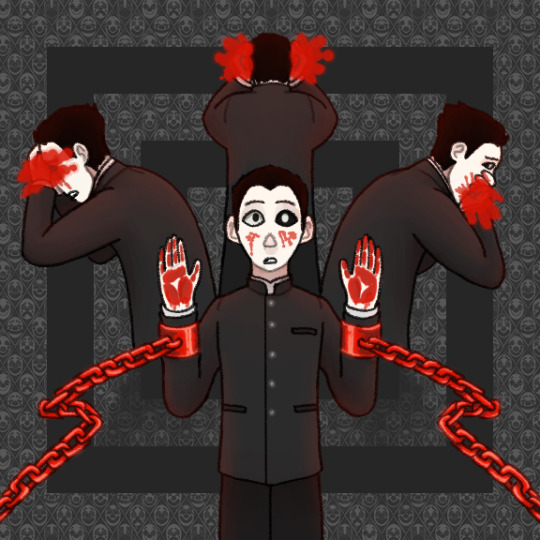
[Image ID: Three digital illustrations, each depicting a different character or group of characters.
The first is a child like figure sitting cross-legged, holding his hands together. He is covered in small bugs, and is smiling at the viewer. He wears a shaggy gray leopard print coat over a white shirt and worn bright pink jeans. His hair is brown and unkempt, spiking up in multiple areas. A glow emanates from his clutched hands. Behind him is a swarm of gnats. The background is a pile of swarming millipedes. An opaque white square helps bring the child into focus.
The second image is of two figures, holding hands and smiling at each other. One figure is on the bottom left, and the other is hanging upside-down from the top right. Their hands meet in the very center of the image. The one in the bottom left wears brown and red tones, except for a pale green undershirt, and has an eyepatch. The one in the top right wears blue and green tones, except for a yellow bra, and has long dark blue hair that fades into the sky. Her eyes give off a faint blue glow. The background behind the left figure is layers of dirt and tree roots. Behind the right figure is clouds and sky.
The third is a group of four figures, each facing a different direction- one in the center, facing the viewer, two behind them, with their backs towards each other, and a fourth in the mid back, with their back to the viewer. All four are wearing Japanese male student uniforms. All figures have unnaturally white skin and dark hair. Their eyes are mostly not visible except for the centermost figure, whose right eye is white with black irises and left eye is black with white irises.
Starting at the leftmost figure, going clockwise, the figures cover their eyes, ears, and mouth, each of which is obscured by bright red smudges. The leftmost figure is crying red, and the rightmost figure is looking towards the centermost figure helplessly. The frontmost figure has both hands held up in surrender, the palms of which are covered in candy-red blood. Red chains snake off red manacles around their wrists. They have smears of red blood on their cheeks, and are looking towards the viewer in shock. The background is in grayscale, and consists of square rings of alternating looped drawings of vintage clown faces and dark gray. End image description.]
Doing some art of my TMA OCs, so I have something to put up on my artfight page for ‘em. Here’s my corruption, buried, vast, and stranger avatars :] I think I spent more time on the description here than I did on some of the art, lol /j
#Wolfy Speaks#Photo Post#tma ocs#tma fanavatars#ugh i always feel like i go overboard with my descriptions but then i'd feel bad if someone wanted to see what i was drawing and couldnt so.#big ol descriptions it is#wolfy does art#wolfy's art#the magnus archives#oc: nat ealer#oc: bryn dall#oc: mušen#oc: Monomyō#you can tell i really phoned in the first background#i dont really get grossed out by bugs personally but man. there are some Images out there.#SPEAKING OF#bugs tw#insects tw#blood tw#hopefully the fact that the words are in the body of the post will alert most of the filters#ok very niche and i know nobody is looking here who would know but if anybody has any resources on sumerian naming practices....#it would be appreciated#there are like a handful of words ive managed to find consistent sources for and i think most of them used the same source anyways#so her name is just a translation of the word bird because. fucking nobody has bothered to talk about how last names worked#if they even had two names at all! maybe everyone went by a first name!#anyways if anyone is wondering abt backstories nat was raised by bugs#bryn fell into the sky caught a tree and managed to claw her way back to the earth#Mušen fell into an impossibly deep well with nothing to look at but the sky tried to climb out slipped at the very top and poof avatar#and the Monomyō squad was built to get into stranger shenanigans but they all were destroyed except for my boi Shirō who is the center one#his name literally means 'fourth son'. you get three guesses what his brothers names are
7 notes
·
View notes
Photo

White Legged Snake Millipede
66 notes
·
View notes
Video
tumblr
Meet Mildred the Millipede - A Tachypodoiulusspecies, more specifically the White-legged snake millipede!
She was just chilling in my backgarden, having a grand old time in my pebbles :) Called her Mildred, because why not!
#millipede#bugs#lots of leggos#gremlincore#trollcore#bugcore#naturecore#arthropods#british garden wildlife#wild millipede#mildred the millipede
22 notes
·
View notes
Text
Millipede #insect
Possibly a White-legged Snake Millipede which I disturbed. Now back sheltering behind the remote camera. Tachypodoiulus niger, provisional identification. If you can help with identification, please leave a message below. #nature #naturephotography #woods #insects

View On WordPress
0 notes
Text
Athene
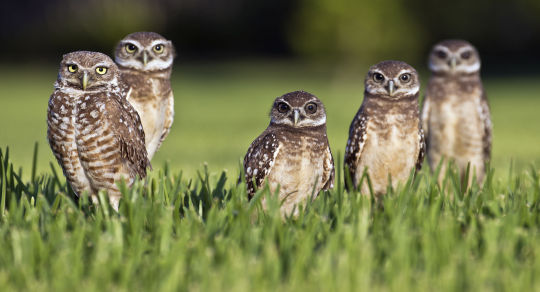
Burrowing Owl, by Travel Way Of Life, CC BY-SA 2.0
PLEASE SUPPORT US ON PATREON. EACH and EVERY DONATION helps to keep this blog running! Any amount, even ONE DOLLAR is APPRECIATED! IF YOU ENJOY THIS CONTENT, please CONSIDER DONATING!
Genus: Athene
Status: Extant
First Described: 1822
Described By: F. Boie
Classification: Dinosauria, Theropoda, Neotheropoda, Averostra, Tetanurae, Orionides, Avetheropoda, Coelurosauria, Tyrannoraptora, Maniraptoriformes, Maniraptora, Pennaraptora, Paraves, Eumaniraptora, Averaptora, Avialae, Euavialae, Avebrevicauda, Pygostylia, Ornithothoraces, Euornithes, Ornithuromorpha, Ornithurae, Neornithes, Neognathae, Neoaves, Inopinaves, Telluraves, Strigiformes, Strigidae
Referred Species: A. brama (Spotted Owlet), A. noctua (Little Owl), A. blewitti (Forest Owlet), A. cunicularia (Burrowing Owl), A. megalopeza, A. veta, A. angelis, A. trinacriae, A. cretensis (Cretan Owl)
Athene is a genus of very small owls that are also quite angry in appearance, and that’s why they get to be featured on birthday week. The genus evolved some time in the very late Miocene of the Neogen, based on fossil evidence - so around 11 million years ago, in the Tortonian age - in Hungary. Many fossil and near-fossil species of Athene are known - including A. megalopeza from the Late Pliocene of Western USA, A. veta from the Early Pleistocene of Poland, A. angelis of the Middle Pleistocene of Corsica, A. trinacriae of the Pleistocene Mallorca, and the Cretan Owl, A. cretensis, which is from the Pleistocene Mediterranean. The Cretan Owl was a flightless member of the species, living on the island of Crete, and it would have been about 60 cm tall. It went extinct, sadly, due to human hunting.
Cretan Owl by Stanton F. Fink, CC BY 2.5
Living members of this genus primarily live in India, though the most famous species, the Burrowing Owl, lives in the Americas. The Burrowing Owl is small, only about 19 to 28 cm long, making them only slightly larger than the American Robin. They have long legs, which are utilized in their Burrowing pursuits, though they are also fast animals. Males and females are fairly similar, with the females being only slightly heavier. They have brown heads and wings, with white chests and brown spotting on their chests. They have very bright eyes and dark yellow or grey beaks. They also look like they’re going to murder you.
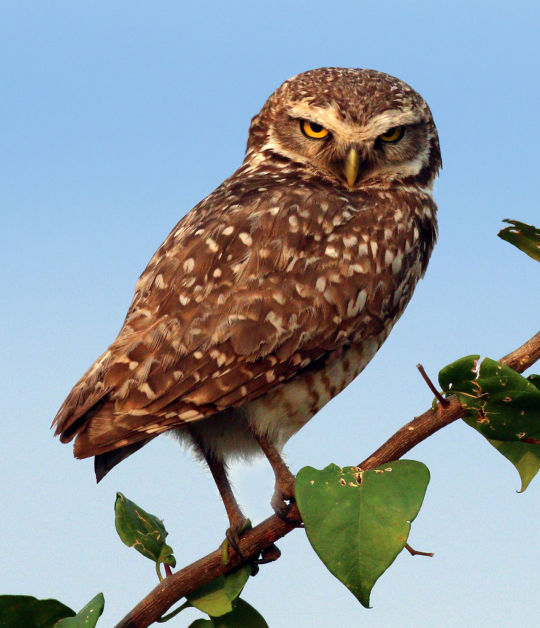
By Charles J. Sharp, CC BY-SA 4.0
Fossil remains specifically of the Burrowing Owl are known from the Bahamas and other locations in Latin America, with most of them becoming extinct due to ecological and sea level changes at the end of the last ice age. They live in the Western United States, portions of Mexico and Florida, and dry areas of South America, and their territory is expanding with increased deforestation. Usually, those birds that live in more Northern locations only stay in those locations for the summer, and then they migrate to the south for the winter. Others that live in warmer locations do so year-long. They nest and roost in burrows made by ground squirrels, and they mimic rattlesnakes - which show a similar behavior - in order to scare off threats. They are a diurnal owl, unlike most other owls.

By Glauxfan, in the Public Domain
Burrowing Owls can live 9 years and even up to 10 in captivity, and are mainly killed by vehicles, badgers, coyotes, and snakes, as well as cats and dogs. They nest in late March or April in North America, and they usually only have one mate, though sometimes males can have two. Pairs of owls will occasionally nest in colonies, usually in open grasslands and prairies, but also places like airports, golf courses, and farms. They nest in underground burrows, which they either find, or dig for themselves. They line their nest with mammal dung and other materials that can control the climate inside the burrow, and eggs are laid every one or two days until 4 to 12 eggs have been laid. These eggs are incubated by the female for three to four weeks while the male brings food, and the parents feed the chicks together. They can begin to make short flights after four weeks and they start to leave the nest at that point, with the parents still helping them for about three months. Sadly, only four to five chicks survive long enough to leave the nest. The owls do, however, in some locations use the same burrow every year, though if they migrate that’s less likely.
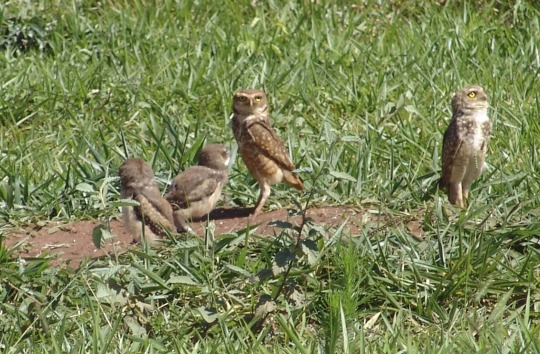
CC BY 2.5
Burrowing Owls hunt by waiting on a perch until they spot prey, swooping down on the prey or flying up to catch insects. They can also chase prey on foot across the ground. They eat many different types of invertebrates and small vertebrates, such as insects and small rodents, as well as some squamates. They are something of a generalist when it comes to insect food, eating everything from katydids and crickets to termites, beetles, and even spiders and millipedes (which aren’t insects but are closely related arthropods). They also occasionally eat fruits and seeds, which is different than other owls. The bird is not considered endangered due it its spread from deforestation, though it is endangered in Canada, threatened in Mexico, and of special concern in most of the USA. It is mostly declining due to loss of habitat and increase of prairie dogs, though they do inhabit human locations. Passive relocation does work to move them, with coercion and enticement used to bring the owls to a new nesting site.

Spotted Owlet, by Lip Kee Yap, CC BY-SA 2.0
The Spotted Owlet, A. brama, lives in India and Southeastern Asia, in open habitats much like its relative. It also has adapted to human environments, similar to the Burrowing Owl. They are small and stocky, only about 21 cm long, with grey-brown feathers and white under-feathers. They lay eggs in holes in trees and buildings, laying only 3 to 5 eggs at a time. They are nocturnal, but often seen during the daytime, bobbing their heads and staring at intruders when disturbed. It hunts insects and small vertebrates, and depending on the location they have shown preferences (such as insects being preferred in Pakistan, whereas rodents are preferred in Jodhpur).
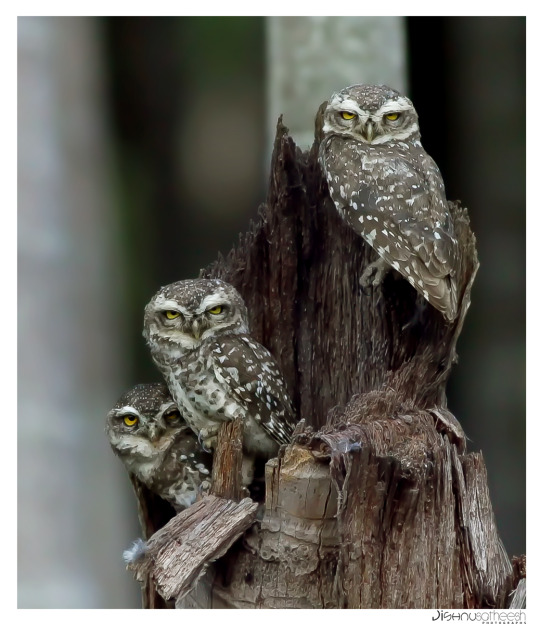
By Jishnu Satheesh Babu, CC BY-SA 3.0
They have a harsh and loud call, beginning chirurr-chirurr-chirurr and ending with chirwak-chirwak, with calls occurring mostly in the dawn or just after sunset. They have a breeding season from November to April, with pairs grasping bills, preening, and feeding each other. The family structure is rather unclear, though males may copulate with many females and females often mating with other females. They nest in cavities, lining the nests with leaves and feathers. They lay about three to four eggs, and they’re incubated as they come out, so the chicks are often a variety of sizes. They feed the young on insects, and later on small vertebrates. Only one or two chicks ever leave the nest, after about 20 to 28 days. They also have a pineal gland, which was thought to be gone in owls.
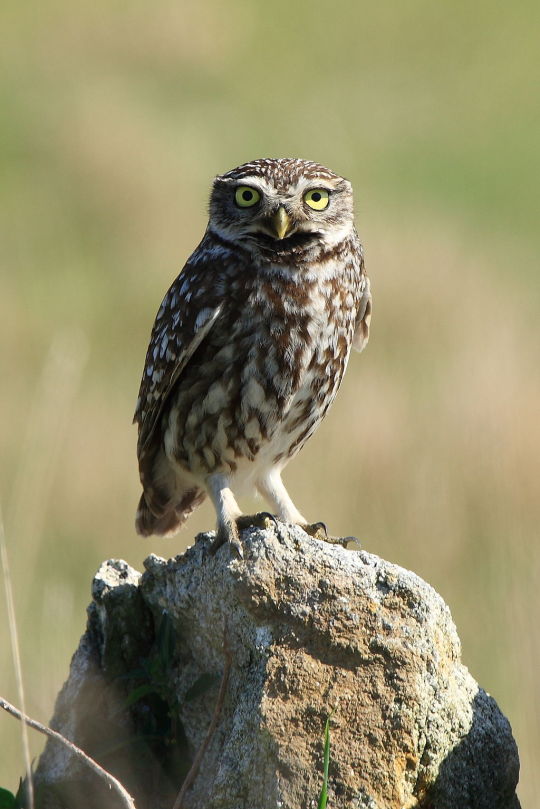
Little Owl, by Arturo Nikolai, CC BY-SA 2.0
The little owl, A. noctua, is from parts of Europe, northern Africa, the Middle East, and central Asia. It is a small, round owl like the other members of its species, with its length only about 22 cm. It is about greyish brown and spotted and streaked both above and underneath. They have a kiew, kiew call, though they can also whistle and trill. They are sedentary and found in open countryside, like the Burrowing Owl, and is often found in villages and suburbs as well. They perch on elevated positions and swoop down to catch small prey, including game birds. They’re also very territorial, with the males remaining in one territory for life, and coming into contact in the spring. They have territorial calls if they encounter one another in their hunting territories, and fly at each other aggressively.
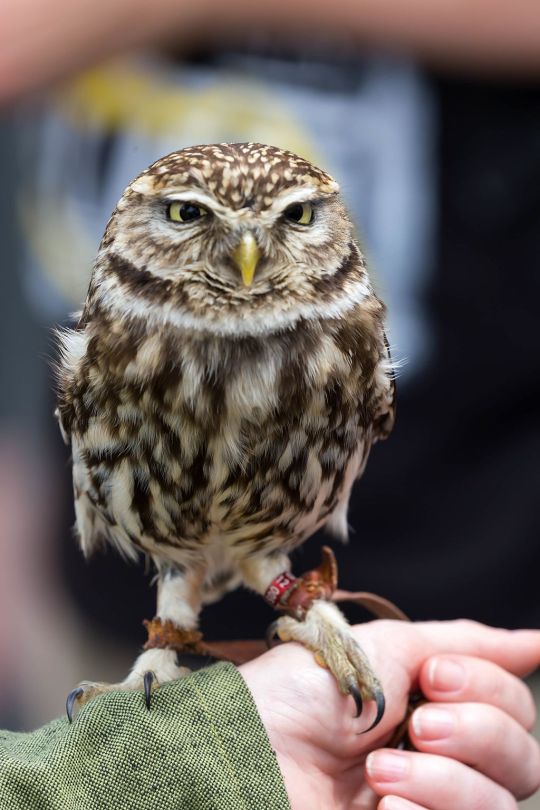
By Marco Verch, CC BY 2.0
If that flight is unsuccessful, the occupier tries to make contact with claws. The owls will drop to the ground and make escapes upon losing. The owls can recognize familiar birds such as neighbours, so they are more aggressive towards unfamiliar birds that wouldn’t normally be around them. They are mostly vocal at night, but they are partially diurnal. During nesting, they can nest in trees, cliffs, quarries, old buildings, and even rabbit burrows, laying clutches of three to five eggs. The female incubates the eggs as the male brings food, and the eggs hatch after 28 to 29 days. The parents will hunt and feed them together, and the young disperse but stay close. The mated pairs stay together for at least a year, but may live together for their whole lives. They live about sixteen years, and can get very used to humans.
By Rasbak, CC BY-SA 3.0
The Little Owl has a large range, and there’s probably between 560k and 1.3mil breeding pairs in Europe, so the global population is probably between five million and fifteen million owls. This population is probably stable, so it is not of concern in conservationist circles. The Little Owl is closely related to the Greek Goddess Athena and the Roman Goddess Minerva, with the owl appearing on coins from 500 BC in Greece. The call of the Owl is said to have heralded the murder of Julius Caesar.

Forest Owlet, by Krishna Khan, CC BY-SA 3.0
The Forest Owlet, A. blewitti, is the last species in this genus, and sadly it is near extinction. It is Critically Endangered and is known from only a few tiny localities in India, which are parts of shrinking forests that are being destroyed by human activity. It is 23 cm long, and stocky, with a large skull and beak. They have fewer spots than the Spotted Owlet and are primarily dark grey-brown, with a white central wedge on its chest. They hunt from perches where they sit still and wait for prey, flicking their tails from side to side when prey is being chased in excitement. They eat mostly lizards, and then some rodents and bird and invertebrates. The males hunt and the females incubate the eggs, with courtship occurring mainly in January to February. They are mostly diurnal, and they bask on tall trees at night. It is losing many of the trees it needs for nesting, which has lead to an extensive decrease in its population, with it estimated that there are only 250 individuals left in the world, since its dense jungles are gone. Individuals are being observed in Wildlife Sanctuaries, including mated pairs.
Sources:
https://en.wikipedia.org/wiki/Cretan_owl
https://en.wikipedia.org/wiki/Athene_(owl)
https://en.wikipedia.org/wiki/Burrowing_owl
https://en.wikipedia.org/wiki/Spotted_owlet
https://en.wikipedia.org/wiki/Little_owl
https://en.wikipedia.org/wiki/Forest_owlet
Guerra, C., P. Bover, J. A. Alcover. 2012. A new species of extinct little owl from the Pleistocene of Mallorca (Balearic Islands). Journal of Ornithology 153 (2): 347 - 354.
Shout out goes to @paukena!
#athene#owl#bird#dinosaur#burrowing owl#little owl#forest owlet#spotted owl#palaeoblr#birblr#athene brama#athene noctua#athene blewitti#athene cunicularia#athene megalopeza#athene veta#athene angelis#athene trinacriae#athene cretensis#paukena#dinosaurs#biology#a dinosaur a day#a-dinosaur-a-day#dinosaur of the day#dinosaur-of-the-day#science#nature#factfile#דינוזאור
103 notes
·
View notes
Photo

Série com o Macaco Prego (Cebus apella) - Series with the Capuchin monkey - 24-08-2008 - IMG_20080824_9999_237 by Flávio Cruvinel Brandão Todos os macacos estão livres na natureza. Os macacos desta série estavam na mata que fica atrás do lago do Jardim Zoológico de Brasília. Macaco-prego Origem: Wikipédia, a enciclopédia livre. Macaco-prego Classificação científica Reino: Animalia Filo: Chordata Classe: Mammalia Ordem: Primates Subordem: Haplorrhini Infra-ordem: Simiiformes (sem classificação): Platyrrhini Família: Cebidae Subfamília: Cebinae Género: Cebus Espécie: C. apella Nomenclatura binominal Cebus apella Linnaeus, 1758 Wikispecies A Wikispecies tem informações sobre: Macaco-prego O macaco-prego (Cebus apella) é um macaco da família dos cebídeos, de hábito diurno e arborícola, que é encontrado em grande parte das florestas tropicais da América do Sul. A espécie possui pelagem marrom-escura com alto da cabeça e pernas negros, cauda negra, preênsil e geralmente com a ponta enrolada. Alimentam-se de frutos, nozes, sementes, flores, insetos, ovos e pequenos vertebrados. Costuma viver em bandos de até dez indivíduos. Também é conhecido pelo nome de mico-preto. Ocorre uma vez ao ano, com uma única cria, cujo período de gestação é de cerca de 6 meses. Os adultos pesam entre 1,1 Kg e 3,3 Kg, enquanto os filhotes têm peso de cerca de 260 gr. A text in english: All of these monkeys are free in nature (In the wild). The monkeys of this series were on trees behind the zoo´s lagoon at the Brasília's Zoo. Capuchin monkey From Wikipedia, the free encyclopedia "Cebus" redirects here; for the communication hardware protocol, see CEBus. Scientific classification Kingdom: Animalia Phylum: Chordata Class: Mammalia Order: Primates Family: Cebidae Subfamily: Cebinae Bonaparte, 1831 Genus: Cebus Erxleben, 1777 Type species Simia capucina Linnaeus, 1758 Species Cebus capucinus Cebus albifrons Weeper uolivaceus Cebus kaapori Cebus apella Cebus libidinosus Cebus nigritus Cebus xanthosternos Cebus queirozi Tufted Capuchin (Cebus apella) Tufted Capuchin (Cebus apella) The capuchins are the group of New World monkeys classified as genus Cebus. Their name comes from their coloration, which resembles the cowls worn by the Capuchin order of Roman Catholic friars. Cebus is the only genus in subfamily Cebinae. The range of the capuchin monkeys includes Central America (Honduras) and middle South America (middle Brazil, eastern Peru, Paraguay). Capuchins generally resemble the friars of their namesake. Their body, arms, legs and tail are all darkly (black or brown) colored, while the face, throat and chest are white colored, and their head has a black cap. They reach a length of 30 to 56 cm (12 - 22 inches), with tails that are just as long as the body. They weigh up to 1.3 kg (2 lb, 13 oz). Like most New World monkeys, capuchins are diurnal and arboreal. With the exception of a midday nap, they spend their entire day searching for food. At night they sleep in the trees, wedged between branches. They are undemanding regarding their habitat and can thus be found in many differing areas. Among the natural enemies of the capuchins are large falcons, cats and snakes. The diet of the capuchins is more varied than other monkeys in the family Cebidae. They are omnivores, eating not only fruits, nuts, seeds and buds, but also insects, spiders, bird eggs and small vertebrate. Capuchins living near water will also eat crabs and shellfish by cracking their shells with stones. Easily recognized as the "organ grinder" monkeys, capuchins are sometimes kept as pets. They are also sometimes used as service animals. Sometimes they plunder fields and crops and are seen as troublesome by nearby human populations.[citation needed] In some regions they have become rare due to the destruction of their habitat. Social structure Capuchins live together in groups of six to 40 members. These groups consist of related females and their offspring, as well as several males. Usually groups are dominated by a single male, who has primary rights to mate with the females of the group. Mutual grooming as well as vocalization serves as communication and stabilization of the group dynamics. These primates are territorial animals, distinctly marking a central area of their territory with urine and defending it against intruders, though outer zones of these areas may overlap. Females bear young every two years following a 160 to 180 day gestation. The young cling to their mother's chest until they are larger, when they move to her back. Adult male capuchins rarely take part in caring for the young. Within four years for females and eight years for males, juveniles become fully mature. In captivity, individuals have reached an age of 45 years, although life expectancy in nature is only 15 to 25 years. Capuchins are considered the most intelligent New World monkeys and are often used in laboratories. The Tufted Capuchin is especially noted for its long-term tool usage, one of the few examples of primate tool use other than by apes. Upon seeing macaws eating palm nuts, cracking them open with their beaks, these capuchins will select a few of the ripest fruits, nip off the tip of the fruit and drink down the juice, then seemingly discard the rest of the fruit with the nut inside. When these discarded fruits have hardened and become slightly brittle, the capuchins will gather them up again and take them to a large flat boulder where they have previously gathered a few river stones from up to a mile away. They will then use these stones, some of them weighing as much as the monkeys, to crack open the fruit to get to the nut inside. Young capuchins will watch this process to learn from the older, more experienced adults. During the mosquito season, they crush up millipedes and rub the remains on their backs. This acts as a natural insect repellent. Self-awareness When presented with a reflection, capuchin monkeys react in a way that indicates an intermediate state between seeing the mirror as another individual and recognizing the image as self. Most animals react to seeing their reflection as if encountering another individual they don't recognize. An experiment with capuchins shows that they react to a reflection as a strange phenomenon, but not as if seeing a strange capuchin. In the experiment, capuchins were presented with three different scenarios: 1. Seeing an unfamiliar, same-sex monkey on the other side of a clear barrier 2. Seeing a familiar, same-sex monkey on the other side of a clear barrier 3. A mirror showing a reflection of the monkey With scenario 1, females appeared anxious and avoided eye-contact. Males made threatening gestures. In scenario 2, there was little reaction by either males or females. When presented with a reflection, females gazed into their own eyes and made friendly gestures such as lip-smacking and swaying. Males made more eye contact than with strangers or familiar monkeys but reacted with signs of confusion or distress, such as squealing, curling up on the floor or trying to escape from the test room. Leia a seguir uma interessante matéria sobre os macacos-pregos, publicada na Folha de São paulo, no endereçohttp://www1.folha.uol.com.br/folha/ciencia/ult306u411970.shtml : Macaco-prego entende valor do dinheiro RICARDO BONALUME NETO da Folha de S.Paulo Mesmo separado do homem por 35 milhões de anos de evolução biológica, o macaco-prego demonstrou em experimentos na Itália possuir uma capacidade demasiado humana: o bicho entendeu o valor simbólico do "dinheiro". Foi a primeira evidência clara de que macacos também conseguem raciocinar com símbolos. A equipe de cinco pesquisadores da Itália e dos EUA testou cinco desses pequenos macacos brasileiros com opções de comida e de objetos usados para simbolizá-la, que serviam como uma espécie de "dinheiro" que os animais podiam trocar por um lanche. Experimento com macacos que envolvia escolha entre alimento e fichas de pôquer mostrou que primata raciocina usando símbolos Experimento com macacos que envolvia escolha entre alimento e fichas de pôquer mostrou que primata raciocina usando símbolos O ser humano já foi definido como a "espécie simbólica", dizem os autores do estudo, liderado por Elisa Addessi e Elisabetta Visalberghi, do Instituto de Ciências e Tecnologias Cognitivas, de Roma. A compreensão de símbolos "transformou drasticamente nossos ancestrais hominídeos ao longo da evolução", escreveram os cientistas em artigo na revista "PLoS One" (www.plosone.org). A capacidade culminou numa linguagem complexa que auxilia acumulação e transmissão de cultura entre gerações. O aprendizado de símbolos já foi observado antes em experimentos com chimpanzés, "parentes" mais próximos do ser humano. Mas que isso fosse possível com animais bem mais distantes evolutivamente, como o macaco-prego (nome científico Cebus apella), foi a grande surpresa agora. Cinco macacos foram testados em gaiolas nas quais tinham a possibilidade de puxar uma entre duas gavetas com comida ou com o "dinheiro" --objetos não-comestíveis, como fichas de pôquer, que as representassem. Os macacos já tinham previamente aprendido a trocar o "dinheiro" por comida; agora o objetivo era testar se isso derivava de um mero condicionamento ou se de fato raciocinavam usando o objeto como símbolo da comida. Primeiro, os pesquisadores testaram suas preferências entre três tipos de alimentos, ordenados como "A", "B" e "C". A idéia era checar um importante traço do processo de decisão, a chamada "transitividade": se prefiro comer "A" a comer "B", e prefiro "B" a "C", certamente vou preferir "A" em relação a "C". Depois, os macacos eram testados com quantidades diferentes tanto de comida quanto de objetos. Os resultados mostraram que os macacos-pregos de fato se comportavam de acordo com a transitividade. Fosse com a comida, fosse com o "dinheiro", eles preferiam "A" a "B", "B" a "C" e "A" a "C". Simbólico e concreto "É um resultado muito interessante", afirma o pesquisador brasileiro Eduardo Ottoni, do Instituto de Psicologia da USP, comentando o estudo. Ottoni colabora com os italianos em pesquisas de campo com macacos-pregos no Piauí. "Ainda que com algum viés ou dificuldade, os macacos conseguiram lidar com o problema simbólico de maneira comparável à maneira com que lidaram com o problema concreto --o ranking qualitativo de preferências e a transitividade se mantém", diz Ottoni. Ou, nas palavras dos autores, "no geral, os resultados sugerem que os macacos-pregos usam mecanismos cognitivos similares quando avaliam opções em ambos os contextos, real e simbólico". http://ift.tt/2kYtrUD
0 notes
Text
supernatural thingies.
In my small neighborhood, I’ve seen pretty strange things. At first glance I see something peeking in my 4th floor window, but when I shoot up the only thing I see is nothing. When I walk home from school, I swear to God I hear someone echoing my footsteps.
In the neighborhood there’s about 3 thingies and 4th that I can’t see. I’ve named them.
Gorgon. Huge gorilla like creature with long arms that reach the ground and legs just as long, if not longer. He walks outside, usually by an old lady with her dog. The dog often barks at nothing, but I think it sees Gorgon, too. I don’t see him very often and like I said, I only see flashes of them. Harmless.
Birdie. She likes watching people from outside of the windows. She shows up at night, but at day time, the birds do her job. Birds often on my balcony or windowsill and just sit there. The birds are usually crows or jackdaws. She has huge eerie eyes and black feathers, a beak and claws. Her body is mostly bird – a very skinny bird – but she has arms. Her arms are dry and calloused. Creepy, but harmless.
Lizzie. They are different from the others. Gorgon looks masculine, while Birdie is feminine, in a strange way. But, Lizzie… It’s hard to say they even have a gender. Do giant, tree climbing millipedes have gender? Mostly harmless.
???, is a mystery. I know they’re there, they’re the one that echoes my footsteps and follow me to school. People often stare at me, not all people, the loners. It seems they look through me or at something above me. When the day is getting especially boring and I’m about to fall asleep, they whisper something into my ear. Sometimes it’s a harmless “wake up”, but sometimes it’s an echoing giggle or a harshly hissed insult. Slightly harmful.
But I have one more thingy. Slither. Slither is feminine, she has a white humanoid body, but the tail of a snake. Her long hair drapes over her tummy and her eyes are devoid of any emotion. She looks sad. Out of all the thingies I’ve mentioned, she is the only one I’ve seen for more than a second at a time. She usually isn’t gone after I blink, she just stays and looks at me. Sometimes she tilts her her head sideways and I see her mouth. It’s sown shut. I wonder if she’s got something to say.
When I reach to touch her, she slithers away and disappears. She stays away from light. When I’m gone for more than a day and when I come back, she hangs around me a lot more. After some vacation, the night I sleep in my own bed after a long time, she touches me. Not harassing me, not in anyway. A finger trailing down my arm, tickling my foot or holding my hand. The first few times I coiled away from her. At first I tried telling my mom, but she brushed it away as being creeped out by the new place – it started when we moved here. By the years, I’ve gotten used to it. Is she the monster under my bed?
Or am I just crazy?
0 notes
Text
The Malicious Maw: An Eye-Opening Excerpt
WARNING: The story snippet below contains intensely graphic situations of a violent and gory nature. Also intense situations and just a generally fucked up situation.
Basically, your nightmares are your own fault should you proceed. I also do not condone this kind of behavior outside of a fictional world. Please ink responsibly.
---------------------
Lickyface is a character that is often on my mind. I always wanted to make a great old one like Lovecraft's greats. Nyarlethotep being my favorite and a constant inspiration, but there are many lovecraftian influences in the character's designs and behavior.
I feverishly wrote this in my notebook one night and have been mulling it over for a while. I figured typing up for this blog would let me have an excuse to unleash Lickypede on the masses! I am planning to expand on this post (and the Inky Blinky Blight snippet) to create a story about this bugger finally.
Thank you for reading! May Lickypede skitter through your hearts and minds. The character below was made by me in the Second Life client. For the bits and ends I used, please consult my flickr.
The Malicious Maw
Hunting Hilarity

The cosmic entity loved to taunt its victim. Haunt its victim with its incessant. Fucking. Laughter.
Be the stifled snickerings from the mouths dotting the creature’s shoulder, like the beast was holding an earth shattering joke from their prey, or the haunting cackling the cracked from its fang encrusted maw. Jittering and chattering like a chucking chorus as the snickering merged with the laughter from the creature’s phonograph-like mouth.
Lickypede’s centipede body coiled itself around its victim’s legs. The appendage’s multitude of legs crawling and tearing at their flesh and skin as it moved.along their body, shoving their legs and arms back in place forcefully, holding them down as the body tightened like a rope around them. Stopping just under their elbows, the open maw stretched across the bissected portion of the millipede half of the massive entity.
As the victim did its best to struggle and push the body away, they would feel layers of the body’s shell flake away. Merely layer after layer of coagulated blood and the entity’s inky, oily tar hardened to make the carapace. It may have been hard as armor, but the outer layers still seemed to be drying. Other areas seemed to being coated from the slobber that dribbled from the mouth eternally stretched open at the body’s front. This meant meaty clumps of gunk clung to their hand like mucus and dyed their skin like ink.
The creature would never stop its damning laughter.
Snickers would sputter into gasping guffaws from the gnarled teeth twitching and oozing oil and tar from the twitching creature’s body. Specks of spittle spattering the victim and environment with the globs of syrupy oil. The stains, like the oils dripping in viscous globs from its oil coated body, would have a strange reflection. Like petrol in water, it spread the light that hit it into the color spectrum. Instead of a beautiful rainbow, something that would stain the victim’s mind like it would the surroundings would show itself.
Instead of bands, the colors of light would spread beyond the plane of the ink splotches would appear to be a chaotically cascading spectrum of dots in a 3d plane beyond the stain. As one moved, the image of ‘dots’ beyond it would appear to move like it was, in reality, a window to another plane. Closer inspection would prove those dots were, in reality, eyes suspended in the inky ocean beyond the reflection. All colored in a sequential rainbow, most staring out into reality, others moving about to focus on this and that.
Every drop of this sinister substance gave the illusion of a single one of these eyes suspended in the black oil as it fell to the ground, spreading into the all-seeing spectrum as it hit the ground. Its laughter slowly ascending in tone. The many mouths adding to the massive mouth’s growling giggling. Adding tension, adding harmony. The threatening snickering almost turning into a song.
Two segments of the coiled body spread, exposing the victim’s stomach, the legs helpful in pushing away the fabric that’d otherwise obscure its target. From the darkness the centipede body’s gaping, teeth framed wound of a segment, the same technicolor spectrum of eyes peering out. The depth and darkness within the carapace became clear as a lumpy, writhing figure appeared from within. At first, it almost looked like a hand groping for something to grab onto, reaching for eyes that were merely obscured by a hand that touched nothing. As the light hit it, it seemed to be merely an illusion. The figure flopping forward to reveal a dripping tongue, spreading a mixture of oil and pus around as it slithered along the carapace teeth. Examining its own teeth it would appear, before snaking its way down towards the victim’s stomach. Tickling and tracing it. Tasting their prey.
The spine that sprouted from the carapace’s mouth angled itself parallel to its victim’s torso. The tar that had coalesced into its upper body creating what passed for the emaciated being’s torso. Hardened as the body went up to the spasming claws and writhing, cackling head of the beast. It had positioned its coiling so it still towered over this, beginning to tilt forward causing the contaminated, concentrated syrup of rancid biological matter to pour over the victim's face. The scent powerful and dizzying, hitting the nose with a powerful sweetness like petrol that evolved into the rancid power of something that had decayed for centuries in an airtight container having never been open until this very moment directly into their nose.
It coated the room, it mader eyes water. It was a lingering stench that seemed to tell a story and every single bit of it made the recipient want to vomit and cry in a synchronized fashion. The victim’s frantically flopping head it roughly grabbed by the massive claw. The ink having hardened and stretched so the palm cupped the entirety of the side of their head like a normal hand could a cheek. Its elongated talons spreading themselves to clench around the entirety of their head. The index and middle talon parallel along their eye. The thumb caressing the chin. The other two did the job of threatening him by pushing the sharp points against the backish side of their neck and head. That hand was far from the victim’s concern.
Suspended above their head, powerless to pull away, the claw’s counterpart crept closer. The index finger pronounced, extended outwards with its target clearly the victim’s tear duct. Inch by inch they would struggle, their eyelid would flutter and twitch. It was to no avail. The claw crept closer at a hauntingly slow speed. Inch by inch the index claw filled their vision.
Octave by octave, that skin grating guffaw grew thunderous.
The index finger hovered closer to the eye, but the lids twitching proved annoying. With the slow and gentle care of a designer with a scalpel, the claw sliced the flesh away. First one lid, then the other. LEaving it lying right on the eye, a shocking feeling. One the victim had never experienced, though that was nothing new in this encounter. It had been absolutely eye-opening. Lickypede was sweet enough to save the victim from the strange experience of a wrinkled petal of flesh resting ever so delicately on the eye, cut so it was held only by being stuck to the wet ocular. With the tactfully tender tone, the tongue-esque tendril tipped towards their eyelid. Plucking it from their face and depositing into one of the mouths of their torso. The bottom lid soon follows.
The victim’s mouth, already fluttering like a flounder spouting screams and sniveling bargains, was forcibly kept open by the thumb dutifully position there. The digit roughly resting against the skin leaving them to gurgle and gasp out their pleas.
Seems Lickyface was sick of this blubbering as well. With an index claw still hovering just centimeters from their now painfully exposed eyeball, the tip centered directly on the pupil, the beast let out a chunky slurry. Most of the pressured stream concentrated to the victim’s open mouth, but it began to hit all around their lips causing a flood to pool everywhere. It was hard to focus on that, as the taste was indescribable, yet their tongue couldn’t escape it. Everywhere it flopped and squirmed in an attempt to evade and escape the taste caused the fleshy tissue that held their tongue down to grow sore. From the new searing pain, like gasoline to a wound, coming from under their tongue, they were certain they might be in danger of it tearing off. Fearing literally swallowing it in order to escape the taste. Suicide by stomach acid.
Their eyes burned as it began to cloud and stain their vision and blinded them completely. The victim would find, as Lickyface graciously began to clean the one eye it seemed fixated on whenever the liquid pooled on it, that this substance continued to blind them after being cleaned. The whites themselves even seemed permanently stained, darkening a shade with each dunk.
The splatter left a clue as to what made up the sludge the creature vomited. Plucked eyeballs laid on the ground, their fleshy tendrils twitching and flopping like they were trying to escape. The tongues seemed to fare better in their attempts. Boney little mandibles having sprouted from the long, spongy mass. The tongues, looking more like centipedes as more and more legs sprouted like the sides, scampered off into the night leaving trails of the pus stained sludge in their wake.
Another of these tonguey centipedes was stuck to the side of the victim’s cheek. Like a trooper, it dug its sharp legs into the victim’s flesh to try and fight the torrent of noxious sludge. Sadly, thanks to Lickypede’s dislike for spilling, it took to using its threatening claw to fix this. A tendril hooks the cheek one after the other from mouth to jaw bone. The poor, stubborn centipede had been spliced right in half spreading a pussy, bloody mess into the sludge. Mouth now able to be forced open far beyond what a human was normally allowed, the torrent continued.
The victim gagged, gurgled, and gasped causing thick bubbles to form along the sides of their mouth. This would be only the beginning of their problems as that talon returned to their eye. Their fears realized as the creature was quick this time, fearing their eye would move. Determined to slice their eye directly along the center of the eye parallel to the horizon should they have been standing straight and able to see.
The pain of the cut mixed with the substance finally invading inside their ocular was a near enlightening experiencing. COming to terms with all their previous pains purely due to the overwhelming magnitude of this long feeling. It made every single broken bone and shattered heart seem like child’s play in comparison to the symphony of sensations they were experiencing now. Their system was similarly shocked, attempting to regurgitate the torrent back. A losing battle, but the attempt was obvious by how the victim spasmed and dry heaved. The wet hurks and gurks escaping through the tar bubbles covering their face.
Lickyface just could NOT have their gift being squandered like this. Luckily, the namesake implied a tongue of its own. Many, really, but the main one was the point at large here. The cosmic boogun thrust its tongue through the torrent of tar and bile, thickening with the target goal being to tamp the toxic transfusion towards their throat. Almost in a mockingly loving fashion the massive tendril would stroke and prod theirs. The eyeball that grew from the collection of crusty oil focused on this, first seemingly being used to play like a piercing. Only for tiny little arms to sprout and grab onto the tongue. Wrestling with it and clamping onto it as the tongue began burrowing towards the back of their mouth.
As the tongue began to force its way down the mark’s throat, the little inkling imp that was ripping their tongue from the bottom of their mouth began to shove the tongue towards their trachea to force the concoction down their trachea, as the massive tongue began to wiggle its way down their esophagus.
The imp, however, would have plucked itself from the tongue in order to lodge itself up towards the victim's nasal cavity. Moving like a sentient blob, it would force the liquid into their nasal cavity. To the victim's horror, the acidic kerosene that seemed to coat their nostrils seemed to be growing something. Correction, it seemed to be causing something to grow from them.
A blemish could be felt in their nostril. One of the few muscle they still had much control over now, every twitch and flair caused them to become acutely aware of the painful lump. Acutely aware of this lump growing with every frantic movement. It was only a matter of seconds before this lump popped, causing a torrent of pus and blood to leak from their nostril like a particularly persistent bloody nose.
From the spot the boil burst, the patsy felt something moving in their skin. Through their pores and the cartilage just behind the wound. Something sprouting in their snot, snaking along the mucus and muscle as it searched for the way out. Something the imp was delighted to direct it towards.
The victims one lone eye could see a tiny tongue sprout from their nose. Just barely as it twisted into view. Growing and sprouting slowly outward.
Worse, they could feel more blemishes bubbling up from their skin.
#fiction#second life#lickypede#lickyface#horror#short story#gore#eye opening#ink#tar#creepy#eldritch evil#great old one#lovecraft#body horror#constriction#eye slicing#tongue tamping#tongue#tongue tendril#monster#creature#beast#boogun
0 notes